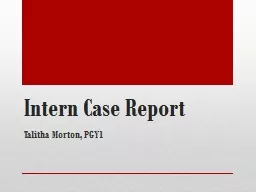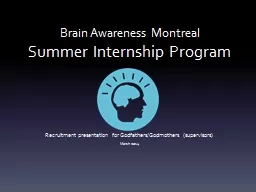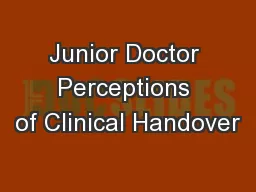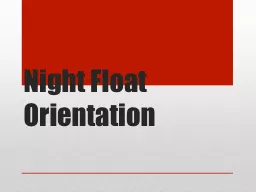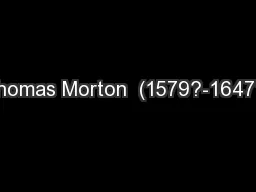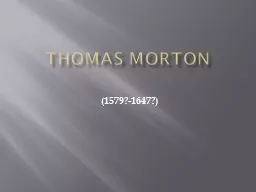PPT-Intern Case Report Talitha Morton, PGY1
Author : cheryl-pisano | Published Date : 2020-04-04
CC Chest pain 61 yr old male presented to ED w substernal nonradiating chest pressure while walking that lasted approximately 30 minutes Bilateral arm numbness
Presentation Embed Code
Download Presentation
Download Presentation The PPT/PDF document " Intern Case Report Talitha Morton, PGY1" is the property of its rightful owner. Permission is granted to download and print the materials on this website for personal, non-commercial use only, and to display it on your personal computer provided you do not modify the materials and that you retain all copyright notices contained in the materials. By downloading content from our website, you accept the terms of this agreement.
Intern Case Report Talitha Morton, PGY1: Transcript
CC Chest pain 61 yr old male presented to ED w substernal nonradiating chest pressure while walking that lasted approximately 30 minutes Bilateral arm numbness and weakness Bilateral . KNMI Internal report = intern rapport; IR 2008-05 De Bilt, 2008 PO Box 201 3730 AE De Bilt De Bilt The Netherlands Summer . Internship . Program. Recruitment presentation for . Godfathers/Godmothers (. supervisors). March 2014. Introduction. Objectives. : . To motivate high school and cegep students to start a research career in neuroscience!. the impact of . efficiency. , . education. and . senior clinician facilitation. Dr Hamish Dunn. Dr Joanna Dargan. Dr Lucy Cho. Background. Role of poor communication in sentinel events. Increasing international focus. Duty Hours. DUTY . HOURS are 8:00 pm - 10:00am daily (Monday - Sunday. ). Finish work by . 9:30 AM. Night Float . Sign-Outs. DRH. HUH. VA. 8: 00 pm daily in the 5N Resident lounge.. Intern takes Intern A sign outs from all teams and Senior takes Intern B sign outs from all teams. Sponsor Request Letter. . Dear Business Owner,. . We know you are asked to make donations throughout the year to many worthwhile organizations, but we would like to introduce you to the BRAND NEW… . 2. . learn. Kyle Parsons. Intern . 2 . Learn & Work Study Coordinator. An undergraduate student employment program designed to:. Provide relevant work experience (internships) through on-campus employment. Jeanine Hodge. Chapter 2: Feelings & Concerns. What are your feelings and concerns as you begin your internship? . Nervous, Eager and Ready to Change the World. What do you see as your primary learning interests and needs? . Case. You point out the features suggestive of delirium, and discuss the importance of prompt . dx. and management. . Your intern rolls her eyes. . What is your working diagnosis?. Definition. A learner who appears not to be eager, willing, and ready to learn what you want to teach. August 2016-17 School Year. Follow Morton!. Facebook: Morton High School Principal’s Page. https://www.facebook.com/MortonHighSchoolPrincipal. Twitter: @MortonHighGovs. Morton Official Logos. Academic Seal. . 2) Peter, the main character, makes a very serious mistake at the end of chapter 1. Explain the immediate results of his actions.. Ch 1. pike. Beadle. Fells. Beck. Crag. Gentry. Malignant. Dale. Thomas Morton. Morton was a lawyer, trader, and adventurer.. One of the founders of the settlement at Mount Wollaston (1625), a trading post about 30 miles from Plymouth Colony.. His aim was to trade with the Indians and encourage others to settle the land.. Thomas Morton. Morton was a lawyer, trader, and adventurer.. One of the founders of the settlement at Mount Wollaston (1625), a trading post about 30 miles from Plymouth Colony.. His aim was to trade with the Indians and encourage others to settle the land.. Pascale International . Fellowship at. McGill University. Julie Becker. Joined CF in 2001. Helped open up Harlem Office. Started Intern Program. Scheduling, HR, Library Grand Opening, Delegation, . Director Intern Program /Alumni Group. FLU SEASON 2018/19. . Consent Privacy and Dignity.. Infection control. Saloni . Gaglani. , GP Care Group. Adapted from Anne Morton's slides. 14th August 2018 . Consent. Consent must always be obtained before every immunisation.
Download Document
Here is the link to download the presentation.
" Intern Case Report Talitha Morton, PGY1"The content belongs to its owner. You may download and print it for personal use, without modification, and keep all copyright notices. By downloading, you agree to these terms.
Related Documents

